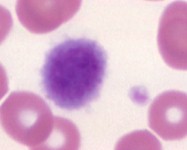Mean Platelet Volume (MPV)
Individual platelets can vary markedly in size within a given sample,
especially in blood from dogs and cats (even in health). The mean platelet
volume is measured only be automated analyzers, such as the Advia.
This measures mean platelet volume in a manner analogous to that described
for the MCV for red cells.
 Extreme variation in platelet size in a blood film from a normal dog.
Extreme variation in platelet size in a blood film from a normal dog.
|
Little is documented in the literature regarding the clinical interpretation
of this parameter. In very general terms, increased MPV might be expected
in "regenerative" thrombocytopenia, i.e., that caused by increased peripheral
loss, destruction, or utilization of platelets and accompanied by increased
production of platelets by marrow (megakaryocytic hyperplasia). Accelerated
thrombopoiesis tends to result in the release of larger platelets (which
also have enhanced functional capabilities). In apparent contradiction
to this generality, one clinical study reported the frequent occurrence
of decreased MPV in dogs with immune-mediated thrombocytopenia
(due to platelet fragmentation), at least in the initial samples from
newly-diagnosed cases.Recent studies in dogs demonstrate that a high
MPV in dogs is a good predictor of an adequate bone marrow response,
however a normal or low MPV in thrombocytopenic dogs does not predict
an inadequate bone marrow response (in other words, in a thrombocytopenic
animal, a large MPV indicates active thrombopoiesis, but a small or
normal MPV does not rule out adequate numbers of megakaryocytes in the
bone marrow).
Healthy cats generally have variably sized platelets, some of them
quite large. Some breeds of dogs, e.g. Cavalier King Charles Spaniels,
have larger platelets than other breeds. These may be missed with some
automated counters (such as the Coulter analyzers) because the platelets
fall outside the size threshold the instrument uses for counting platelets.
This does not occur with the Advia analyzer, which counts platelets
of all sizes.
Our experiences with this parameter have not shown it to be highly
useful in distinguishing between various causes of thrombocytopenia
in animals.
Last Updated: June 2000
|